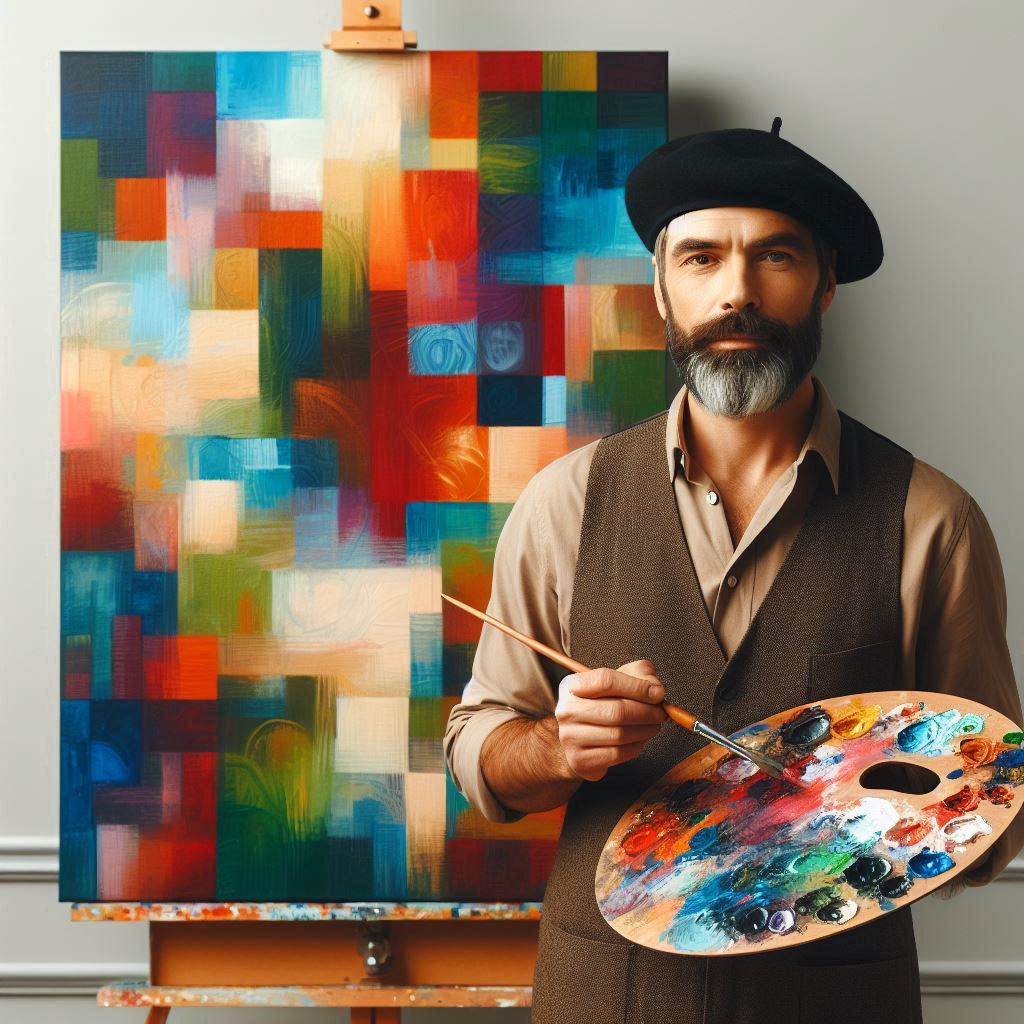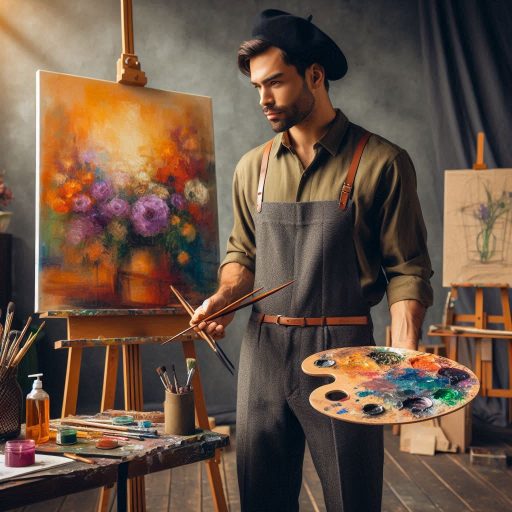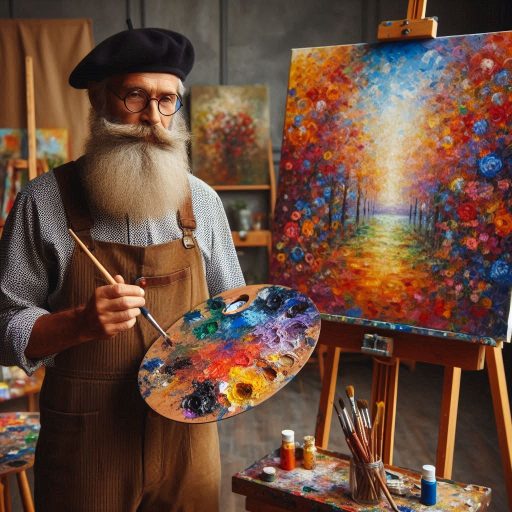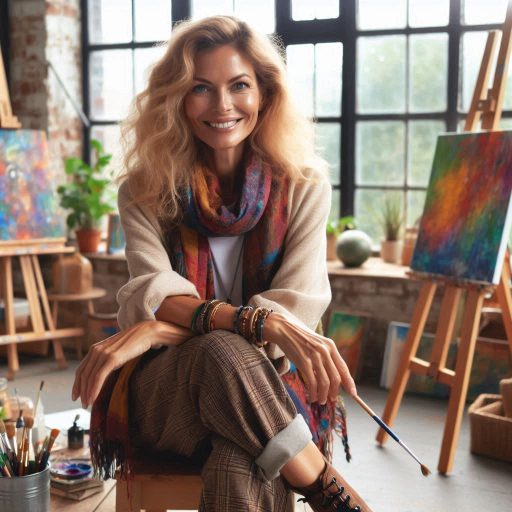Introduction
Mental health is an essential component of our overall well-being, influencing how we think, feel, and interact with the world.
It affects every aspect of our lives, from our relationships and work to our ability to cope with stress and overcome challenges.
Unfortunately, despite its importance, mental health is often surrounded by stigma, making it difficult for many to seek help or openly discuss their struggles.
This is why having conversations about mental health is so critical—it encourages greater awareness, understanding, and acceptance.
In this blog, we will delve into the powerful role that art can play in supporting mental health.
We’ll explore how creative activities such as painting, music, writing, and other forms of artistic expression offer therapeutic benefits, helping individuals process emotions, manage stress, and promote self-awareness.
By incorporating art into mental health practices, individuals can discover new avenues for emotional healing and personal growth.
Through this discussion, we hope to highlight the value of art in mental health and inspire readers to consider how creativity can enhance their own well-being.
The Therapeutic Benefits of Art
How engaging in art activities can reduce stress and anxiety
Engaging in art activities significantly reduces stress and anxiety.
By focusing on creative tasks like painting or drawing, individuals enter a mindful state that shifts attention away from stressors.
This concentration on the present moment creates a calming effect on the mind.
Engaging in art helps alleviate overwhelming feelings by offering a therapeutic outlet.
Art serves as a break from daily worries, allowing people to release tension and cultivate mental relaxation.
It becomes a tool for processing emotions, promoting inner peace and balance.
Art as a form of self-expression and emotional release
Art provides a powerful avenue for self-expression and emotional release, especially for those struggling with inner turmoil.
For people who find it difficult to communicate their emotions verbally, art allows them to channel their feelings through colors, shapes, and forms.
This creative process helps individuals explore complex emotions and gain a better understanding of their inner state.
Art also gives people control over how they express their feelings, fostering a sense of empowerment.
The act of creating often leads to emotional catharsis, releasing pent-up emotions in a safe, constructive way.
Examples of art therapy techniques used in mental health treatment
Various art therapy techniques are used to support mental health treatment.
Expressive art therapy encourages the use of different mediums like clay, watercolors, or pastels to explore emotions.
This method allows individuals to engage in new forms of expression and experiment with creativity.
Guided imagery is another technique where therapists prompt individuals to visualize a calming scene and recreate it artistically, enhancing relaxation.
Mandala drawing is commonly used to reduce stress and anxiety.
Creating or coloring mandalas involves focusing on repetitive patterns, which provides mental clarity and helps calm racing thoughts.
The structured, repetitive nature of this activity is especially helpful for those experiencing anxiety.
Collage-making is another effective technique.
Individuals cut out and assemble images that represent their emotions, experiences, or memories.
This process encourages self-reflection and can lead to greater emotional insight.
The act of choosing specific images and arranging them meaningfully helps individuals connect with and understand their inner emotional landscape.
Art therapy techniques provide individuals with a variety of ways to express their emotions, depending on their personal preferences.
Whether through painting, drawing, or sculpting, these methods give people the freedom to engage in a creative process that fosters healing and growth.
Art becomes a bridge between the internal self and external world, allowing for safe exploration of emotions.
Read: Best Tools and Software for Character Designers
Art as a form of mindfulness
Creating art can serve as a powerful tool for mindfulness.
When individuals engage in artistic activities, they naturally focus on the present moment.
The process of selecting colors, shaping objects, or drawing lines demands full attention.
This immersion into the creative task pulls the mind away from worries about the past or future, fostering a deep sense of presence.
Art creates a meditative experience that calms mental chatter, making it a valuable tool for individuals seeking relaxation and peace.
How creating art can help individuals focus on the present moment
The act of creating art helps people remain grounded in the here and now.
Whether it’s painting, sculpting, or sketching, art invites individuals to direct their attention to the task at hand.
This focus reduces rumination on external stresses or internal anxieties.
Instead, the creative process becomes an anchor, helping the mind settle into the present.
Engaging in art keeps individuals mindful of each stroke, shape, or color, drawing them into the present moment and encouraging mental clarity.
Using art to improve concentration and attention
Art is a powerful way to improve concentration and attention.
When people create art, they enter a flow state, where their thoughts, actions, and focus align harmoniously.
This flow enhances attention span and strengthens cognitive abilities.
Art encourages individuals to remain concentrated on intricate details, such as shading a drawing or crafting precise patterns.
This attention to detail not only helps with creativity but also trains the brain to stay focused on other tasks in daily life, improving overall concentration.
Incorporating art into mindfulness practices for mental health benefits
Incorporating art into mindfulness practices amplifies the mental health benefits of both.
Activities like mindful drawing or coloring mandalas are excellent ways to combine creativity with mindfulness techniques.
These practices encourage individuals to focus fully on their artistic creations, enhancing relaxation.
Art can also be used in mindful breathing exercises, where individuals create while focusing on their breath.
This combination of deep breathing and artistic expression reduces anxiety, promotes calmness, and supports emotional well-being.
Mandala drawing, for example, helps individuals center their thoughts through repetitive, symmetrical designs, which are both soothing and meditative.
The process of creating intricate mandalas requires focus and patience, making it an ideal addition to mindfulness routines.
Similarly, mindful painting involves slow, deliberate strokes, inviting individuals to observe each movement without judgment.
Using art as a form of mindfulness offers numerous mental health benefits.
It improves concentration, focuses the mind on the present, and can be incorporated into mindfulness practices to reduce anxiety and promote emotional well-being.
Art becomes a peaceful space where mindfulness and creativity intersect, offering healing and relaxation.
Read: Ceramic Art: From Hobby to Professional Career
Art and self-discovery
Art provides a valuable pathway for self-discovery, helping individuals explore their thoughts and feelings in ways words cannot.
Through creative expression, people gain insights into their inner worlds.
The act of creating art allows individuals to visually represent their emotions, thoughts, and beliefs, offering a deeper understanding of themselves.
This self-awareness often leads to emotional healing and personal growth, making art a powerful tool for introspection.
How art can help individuals explore their thoughts and feelings
Creating art can help individuals delve into their inner worlds, revealing hidden thoughts and emotions.
Through drawing, painting, or sculpting, people access parts of their minds that might otherwise be difficult to reach.
By externalizing these internal experiences, individuals gain clarity about their feelings.
This process provides a safe space to explore complex emotions and allows for self-reflection.
The visual representation of thoughts and emotions often reveals deeper truths that might have remained unconscious or suppressed.
Using art to uncover subconscious emotions and beliefs
Art has the power to unlock subconscious emotions and beliefs that lie beneath the surface.
The creative process can reveal underlying fears, desires, or unresolved conflicts.
When individuals allow themselves to express freely through art, their subconscious mind often communicates through the symbols, colors, or images they create.
This can lead to new realizations about their emotional state or life circumstances.
Art therapy techniques often encourage this exploration, enabling individuals to confront emotions they may not be fully aware of.
For example, abstract art can serve as a reflection of subconscious thoughts, where the choice of color, shape, and form may express hidden emotions.
Art allows these thoughts to emerge in a non-verbal way, offering an alternative method to process emotions that are difficult to articulate.
Uncovering these subconscious layers can lead to significant breakthroughs in personal development and healing.
Examples of art prompts and exercises for self-discovery
Several art prompts and exercises can assist individuals in their journey of self-discovery.
One effective prompt is to “draw your emotions.
” Individuals can express their feelings visually, whether they are happy, sad, or conflicted.
This exercise encourages them to connect with their emotions and understand them better.
Another helpful prompt is “create a timeline of significant life events.
This allows individuals to reflect on key moments in their lives, exploring how these experiences have shaped their identity and beliefs.
Another exercise is “visualize your inner critic.
This prompt asks individuals to draw or paint how they perceive their inner critic, allowing them to externalize negative self-talk and understand its impact.
Once the inner critic is represented visually, individuals can explore ways to manage or transform this critical voice into a supportive one.
Collage-making is another effective self-discovery tool.
By assembling images that resonate with personal experiences, individuals create a visual narrative that helps uncover their values, aspirations, and emotions.
The process of selecting images that speak to them can reveal hidden desires or unresolved issues.
Read: How to Create Memorable Characters: Pro Tips

Art as a tool for communication
Art serves as a powerful tool for communication, especially for individuals facing mental health challenges.
When verbal expression becomes difficult, art provides an alternative way to convey emotions, thoughts, and experiences.
For many, finding the right words to express how they feel is challenging.
Through colors, shapes, and images, art becomes a bridge that allows individuals to communicate in ways that go beyond language.
How art can bridge the gap in verbal communication for those with mental health challenges
Many individuals with mental health challenges struggle to articulate their feelings verbally.
Anxiety, depression, trauma, and other conditions often make it hard to express emotions through words.
Art bridges this communication gap, offering a visual language that conveys complex emotions without the need for verbal explanation.
It enables individuals to communicate what they feel inside, whether it’s fear, sadness, or confusion, in a way that feels less overwhelming.
This non-verbal form of communication gives individuals a sense of relief and a safe space to express themselves.
Using art to express difficult emotions and experiences
Art allows individuals to express emotions and experiences that are too difficult to verbalize.
Creating artwork provides a means of externalizing emotions such as anger, grief, or despair in a non-threatening way.
Through art, individuals can represent their pain or struggles without feeling pressured to explain them verbally.
For example, someone might use dark colors or harsh lines to depict feelings of depression, allowing them to express their emotions visually rather than through words.
This process of externalization can help individuals confront difficult emotions and experiences at their own pace.
It enables them to reflect on their feelings and gain insights into their emotional state.
Art allows them to process complex emotions in a way that feels safe and controlled, promoting emotional healing over time.
Incorporating art into therapy sessions to enhance communication
Incorporating art into therapy sessions enhances communication between clients and therapists.
Art therapy encourages clients to express themselves visually, which can often lead to deeper conversations about their emotions.
When words fail, the artwork speaks, revealing emotions and thoughts that may have been suppressed or too painful to express directly.
The therapist can use the artwork as a starting point for discussions, helping clients explore their feelings in a non-intrusive way.
Art therapy techniques often involve prompts that guide individuals in expressing their emotions.
For instance, a therapist might ask a client to “paint what anxiety feels like.
” This exercise allows the client to visualize their anxiety, making it easier to discuss its impact on their life.
Other techniques include creating visual timelines or mood boards, which help individuals organize their thoughts and emotions in a way that feels manageable.
Art therapy is especially helpful for children or individuals with conditions like autism, PTSD, or schizophrenia, where verbal communication may be limited.
Through artistic expression, these individuals can convey their feelings and experiences, helping therapists understand their emotional needs more effectively.
Read: Ceramic Art Exhibitions to Visit in 2024
Transform Your Career Today
Unlock a personalized career strategy that drives real results. Get tailored advice and a roadmap designed just for you.
Start NowArt and mental well-being
Engaging in creative activities has a profound impact on mental well-being.
Art not only boosts mood but also improves overall mental health.
Whether through painting, drawing, sculpting, or crafting, creating something with your hands brings joy and satisfaction.
The act of expressing oneself artistically creates a sense of accomplishment, which can lift one’s spirits and foster positivity.
Art gives individuals a tool to reconnect with their emotions and create a space for mental rejuvenation.
How engaging in creative activities can boost mood and improve overall well-being
Creative activities, like art, are known to enhance mood by promoting relaxation and mindfulness.
Engaging in art allows people to focus on the present moment, which can shift their attention away from stress and worries.
Art provides an emotional release that helps clear the mind, reducing negative thoughts.
The sense of achievement that comes from completing a creative project also contributes to a positive mood, making individuals feel productive and fulfilled.
Studies show that engaging in art can trigger the release of dopamine, a neurotransmitter associated with happiness, further boosting mood.
Art also serves as an outlet for processing emotions, helping individuals manage feelings of sadness or anxiety.
By creating something visually expressive, they channel their emotions in a constructive way.
This emotional release contributes to a more balanced state of mental well-being.
Using art to increase self-esteem and self-confidence
Art can play a significant role in increasing self-esteem and self-confidence.
The act of creating something meaningful fosters a sense of personal accomplishment.
For individuals who struggle with self-worth, producing a piece of art offers proof of their capabilities.
It shows that they can take an idea from their imagination and bring it into the real world.
This creative process builds confidence, particularly as individuals improve their artistic skills over time.
Art also helps individuals explore and celebrate their uniqueness.
In a world where external validation often shapes self-esteem, art provides an opportunity for individuals to express their authentic selves without judgment.
This creative freedom enhances self-worth and encourages individuals to embrace their individuality.
Incorporating art into daily routines for mental health maintenance
Incorporating art into daily routines can serve as a powerful tool for maintaining mental health.
Regular creative activities provide consistent emotional outlets and help reduce stress.
Whether it’s a few minutes of doodling, journaling, or coloring, these small creative breaks allow individuals to decompress and clear their minds.
Establishing a daily art practice promotes mindfulness and emotional well-being.
By making time for creativity, individuals create space for self-reflection, emotional release, and relaxation.
Art can become part of a broader self-care routine that includes other practices like exercise, meditation, and journaling, contributing to long-term mental health maintenance.
Additionally, having a creative routine can provide a sense of structure and accomplishment, which supports emotional stability.
In general, art offers tremendous benefits for mental well-being.
It helps boost mood, enhances self-esteem, and serves as a consistent practice for mental health maintenance.
By engaging in creative activities, individuals can support their emotional health and foster personal growth.
Cultivating creativity for mental health
Fostering creativity through art can significantly stimulate the mind and promote mental wellness.
Engaging in creative activities enhances cognitive function and emotional well-being.
Art encourages individuals to explore their imagination, enabling them to express thoughts and feelings in new and innovative ways.
This process nurtures a sense of playfulness and curiosity, which can be vital for mental health.
How fostering creativity through art can stimulate the mind and promote mental wellness
Creativity stimulates various areas of the brain, enhancing critical thinking and problem-solving abilities.
When individuals engage in artistic expression, they activate their imaginations, leading to new ideas and perspectives.
This mental stimulation encourages flexibility and adaptability, which are essential skills for navigating life’s challenges.
Moreover, creativity serves as an emotional outlet, allowing individuals to process and release feelings.
Engaging in art can reduce anxiety, depression, and stress, promoting a more balanced mental state.
This emotional release helps individuals manage their emotions better and cultivates resilience.
As a result, cultivating creativity through art can significantly enhance overall mental wellness.
Using art to problem-solve and think outside the box
Art encourages individuals to approach problems with an open mind and innovative spirit.
Engaging in creative activities allows individuals to explore different perspectives and solutions.
When faced with challenges, turning to art can offer a fresh approach, as creativity thrives on experimentation and exploration.
For example, visualizing a problem through drawing or painting can help individuals see it from a new angle.
This creative process encourages them to brainstorm solutions outside conventional thinking.
By using art as a problem-solving tool, individuals can break free from limiting thought patterns and develop new strategies for coping with challenges.
Artistic activities also promote divergent thinking, which is essential for generating unique solutions.
This thinking style encourages individuals to think broadly and creatively, exploring multiple possibilities.
As individuals develop their problem-solving skills through art, they build confidence in their ability to tackle challenges in various aspects of life.
Encouraging creative expression as a way to improve mental health
Encouraging creative expression is essential for improving mental health.
Artistic activities provide a platform for individuals to explore their thoughts and emotions.
Engaging in creative expression fosters self-awareness and self-acceptance, allowing individuals to embrace their unique identities.
Creating art also encourages mindfulness, as it requires focus and presence in the moment.
This mindfulness practice can lead to reduced stress and anxiety, contributing to better mental health.
By prioritizing creative expression, individuals can build resilience and improve their emotional well-being.
Incorporating creative activities into daily routines helps cultivate a habit of self-expression.
Whether through painting, writing, music, or any other form of art, these activities offer individuals a safe space to explore their feelings and experiences.
Over time, this consistent engagement can lead to lasting improvements in mental health.
Cultivating creativity through art is vital for promoting mental health.
It stimulates the mind, enhances problem-solving skills, and encourages self-expression.
By embracing creativity, individuals can foster resilience, improve emotional well-being, and cultivate a fulfilling life.
Conclusion
As we come to the end of this discussion, let’s recap the main points that have been highlighted throughout this blog post.
We have explored how art can play a crucial role in promoting mental health and well-being.
From reducing stress and anxiety to providing a form of expression, art therapy has shown to be a valuable tool in improving mental health.
It is essential to recognize the significance of incorporating art into mental health practices.
By leveraging the therapeutic benefits of art, individuals can find new ways to cope with challenges and connect with their emotions.
The creative process involved in making art can facilitate personal growth and self-discovery.
Therefore, a call to action is extended to all readers to consider incorporating art into their own mental well-being practices.
Whether it’s through painting, drawing, writing, or any other form of creative expression, taking the time to engage in art can offer a sense of calm and healing.
Embrace the power of art in nurturing your mental health and explore its transformative potential.
[E-Books for Sale]
The Big Book of 500 High-Paying Jobs in America: Unlock Your Earning Potential
$19.99 • 500 High-Paying Jobs • 330 pages
Explore 500 high-paying jobs in America and learn how to boost your career, earn more, and achieve success!
See All 500 High-Paying Jobs of this E-Book
1001 Professions Without a Degree: High-Paying American Jobs You Can Start Now
$19.99 • 1001 Professions Without a Degree • 174 pages
Discover 1001 high-paying jobs without a degree! Unlock career tips, skills, and success strategies for just $19.99!




